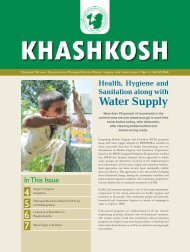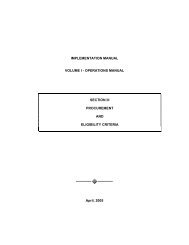ANNUAL REPORT_2008.pdf - Rural Water Supply and Sanitation ...
ANNUAL REPORT_2008.pdf - Rural Water Supply and Sanitation ...
ANNUAL REPORT_2008.pdf - Rural Water Supply and Sanitation ...
You also want an ePaper? Increase the reach of your titles
YUMPU automatically turns print PDFs into web optimized ePapers that Google loves.
Environment Management<br />
Plan <strong>and</strong> <strong>Water</strong> Quality<br />
Environmental Management Plan<br />
E<br />
nvironmental<br />
Management Plan<br />
(EMP) aims to develop<br />
a framework for<br />
incorporating the mitigation measures<br />
in the project cycle <strong>and</strong> monitoring of<br />
the environmental performance. The<br />
EMP is expected not only to reduce<br />
the negative environmental impacts<br />
both due to the project components<br />
<strong>and</strong> caused by exogenous factors on<br />
the services delivered by the project<br />
but also helps to enhance the<br />
environmental benefits of the project.<br />
The environmental protections such as<br />
source protections, surface drainage<br />
improvement, protection of pipeline,<br />
fencing works <strong>and</strong> overflow <strong>and</strong> waste<br />
water management are most common<br />
works proposed at the scheme levels.<br />
Environmental Management Plan of<br />
the scheme is prepared during the<br />
development phase which is further<br />
incorporated in design <strong>and</strong> estimate of the<br />
scheme <strong>and</strong> implemented accordingly<br />
during implementation phase.<br />
The Board has been contributing for<br />
catchments protection <strong>and</strong> drainage<br />
improvement works under EMP in<br />
Batch-V, Batch-VI <strong>and</strong> Batch-VII.<br />
In this connection, water quality test<br />
of Batch V implemented schemes are<br />
completed <strong>and</strong> the test reports have<br />
been already sent to the respective<br />
communities through SOs. The test<br />
results of <strong>Water</strong> Quality of Batch V<br />
have been discussed <strong>and</strong> shared<br />
among the concerned staffs of the<br />
Board. The concerned SOs are also<br />
being formally informed to go to the<br />
communities to aware them for any<br />
pollution risks that Batch V water<br />
quality test (Implementation) results<br />
have shown <strong>and</strong> suggest them to take<br />
measures like source protection,<br />
pipeline leakage control <strong>and</strong><br />
appropriate water treatment in<br />
household level like boiling, sodis,<br />
filtration, use of water guard <strong>and</strong>/or<br />
use of water purifying substances like<br />
Piyus <strong>and</strong> Nirmal Chakki.<br />
The water quality tests of Batch VI<br />
implementation phase schemes are<br />
being carried out by water labs in the<br />
field. The required protection<br />
measures from water quality aspects<br />
have been already applied in the<br />
design of Batch VI schemes. Similarly,<br />
the water quality test results of Batch<br />
VII development phase are being<br />
received <strong>and</strong> being taken care in the<br />
design of Batch VII schemes.<br />
Moreover, the st<strong>and</strong>ard formats of<br />
community water quality monitoring<br />
have been sent to the Batch V<br />
communities <strong>and</strong> 48 filled-up formats<br />
have been already received at the<br />
Board with Batch V post<br />
implementation phase reporting.<br />
The Board has carried out water<br />
quality test of 333 schemes of Batch-<br />
V with 427 samples at the proposed<br />
sources in the Development Phase<br />
<strong>and</strong> it has been done in three major<br />
categories: sanitary inspection;<br />
physical/chemical parameters <strong>and</strong><br />
bacteriological test.<br />
Results of the water quality test of<br />
333 schemes of Batch-V with 427<br />
samples have been summarized in<br />
4 categories: no risk; less risk;<br />
medium risk; <strong>and</strong> high risk. Only 1%<br />
sources are found to be of<br />
considerable risk through sanitary<br />
inspection <strong>and</strong> physical/chemical<br />
parameters test results.<br />
<strong>Water</strong> Quality Test<br />
<strong>and</strong> Improvement<br />
The Board has been carrying out<br />
water quality test of the proposed<br />
water sources to ensure the quality<br />
of drinking water supply. The water<br />
quality test of the proposed sources<br />
is conducted during Pre-feasibility,<br />
Development Phase as well as after<br />
implementation of the scheme.<br />
Risk Type<br />
No Risk<br />
Less Risk<br />
Physical/Chemical Parameters<br />
All Physical <strong>and</strong> Chemical Parameters within WHO GV<br />
All Physical <strong>and</strong> Chemical Parameters within WHO GV<br />
expect Turbidity PH<br />
Medium Risk All Physical <strong>and</strong> Chemical Parameters within WHO GV<br />
expect Turbidity PH, Chloride, Manganese, Calcium <strong>and</strong><br />
Arsenic (>50ppb)<br />
High Risk<br />
All Physical <strong>and</strong> Chemical Parameters within WHO GV<br />
expect Turbidity PH, Color, Chloride, Arsenic,<br />
Manganese, Calcium, Ammonia <strong>and</strong> Nitrate<br />
12 · RWSSFDB Annual Report 2008


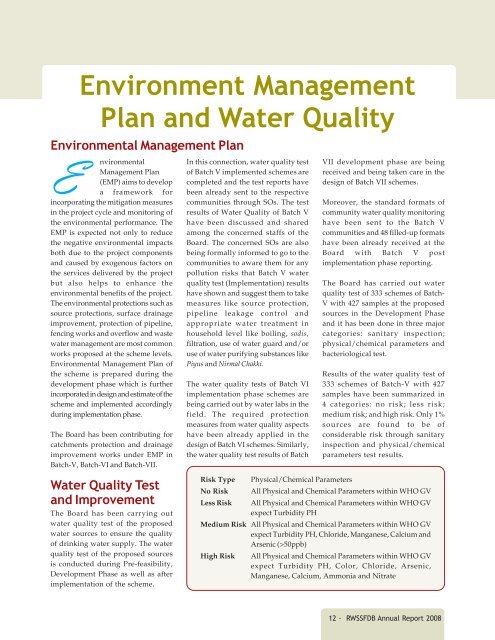
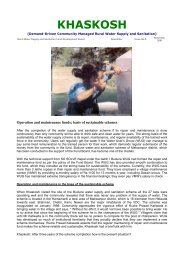
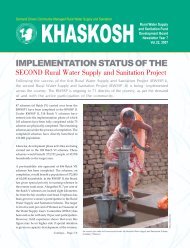
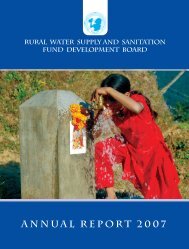
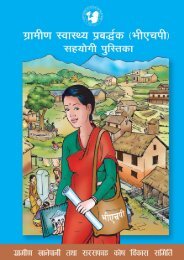


![vfg]k fgL tyf ;/;kmfOsf] If]qdf sf]if ljsf; ;ldltsf] cjwf/0ff pTs[i7 cEof](https://img.yumpu.com/38832733/1/190x245/vfgk-fgl-tyf-kmfosf-ifqdf-sfif-ljsf-ldltsf-cjwf-0ff-ptsi7-ceof.jpg?quality=85)

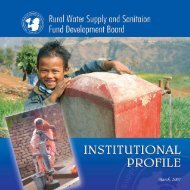
![Request for Proposals RFP # [162] - Rural Water Supply and ...](https://img.yumpu.com/38832347/1/184x260/request-for-proposals-rfp-162-rural-water-supply-and-.jpg?quality=85)
